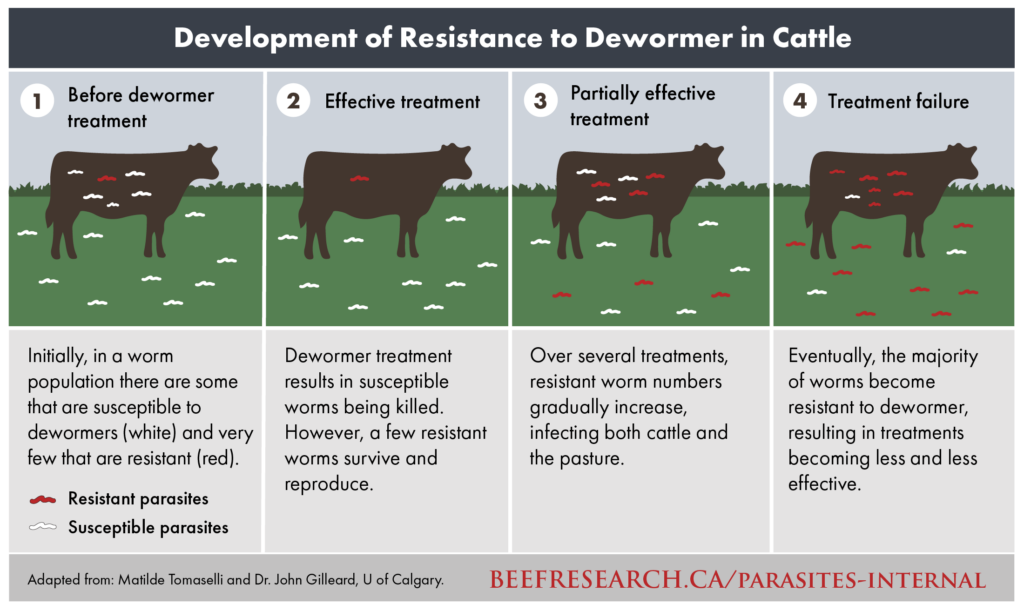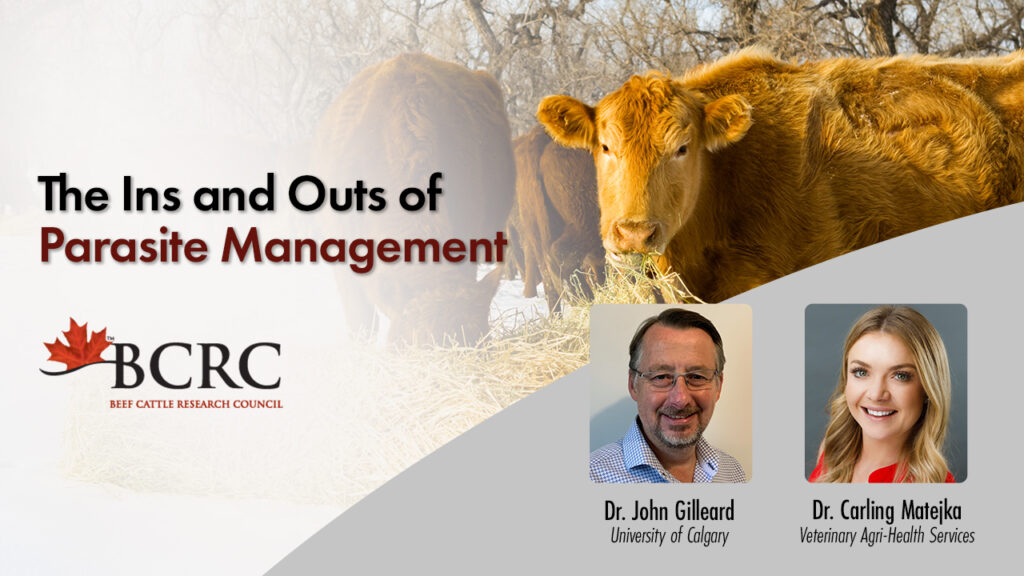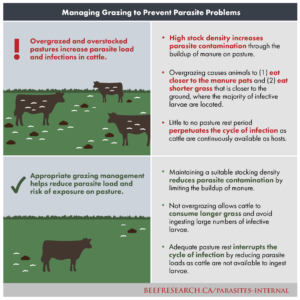The Ins and Outs of Parasite Management Webinar Recap
During the BCRC’s March 2025 webinar, The Ins and Outs of Parasite Management, Dr. John Gilleard, University of Calgary Faculty of Veterinary Medicine, and Dr. Carling Matejka, Veterinary Agri-Health Services, shared science-based strategies for managing internal and external parasites to ensure healthy beef cattle herds and to prevent resistance.
Dr. Gilleard and Dr. Matejka emphasized that parasites may be small, but their impact on beef cattle health, productivity and profitability is significant. The discussion focused on helping beef producers better understand parasite risk and resistance. They provided practical tips on how to shift from routine treatments to more targeted, sustainable pest control, ultimately, arming cattle producers with the knowledge to better monitor, assess and manage parasites while protecting herd health and long-term treatment options.
Why Resistance Is Rising
The webinar opened with the big questions, “Why are we seeing resistance, why is it growing, and what do we do about it?” Dr. Gilleard explained that years of routine endectocides use (like Ivermectin) have increased parasite resistance.
“Blanket treating the whole herd year after year is no longer sustainable,” says Gilleard. He recommends moving from a “treat-first” approach to an “assess-first” strategy. In other words, testing first to see what is needed, then treating only when necessary, with the right product at the right time.
Treat-first: Apply treatment to all animals as part of management, whether it has been determined to be needed or not.
Assess-first: Testing to find out what you need for treatment, and using the proper form and dosage, for a more targeted approach.
Three Parasite Management Tools
Beef cattle producers face several challenges when it comes to managing parasites. It can be difficult to assess parasites in the herd and the impact they’re having, especially since diagnostic tools are limited and every operation is different. Working with a veterinarian to build a treatment plan is key.
Dr. Gilleard highlighted three broad tools beef producers can use to manage parasites effectively:
1. Grazing management: Grazing strategies can help reduce parasite exposure and slow drug resistance, preserving the effectiveness of parasite treatment and improving long-term herd health. Rotational grazing and avoiding high-risk pastures can lower internal parasite loads without the use of more drugs.
2. Monitoring parasite loads: Fecal egg counts and other diagnostic tools allow producers to know when and if treatment is needed, reducing costs and resistance risk.
3. Targeted deworming: Using dewormers based on risk, not routine, helps preserve treatment options. Correct dosing and leaving some animals untreated (refugia) slow resistance and keep dewormers effective long-term.
Targeted Management Plans for Internal and External Parasites
Both Dr. Gilleard and Dr. Matejka stressed the effects of parasites on cattle, highlighting how parasites quietly reduce cattle performance–costing producers gain, reproduction efficiency and ultimately profit–without always showing obvious signs.
- Targeted Management Plan for Internal Parasites: Dr. Matejka discussed the testing, timing and selective treatments to control internal parasites, which are harder to physically see, but pose just as severe, if not more of a threat to beef cattle than external parasites do.
- Targeted Management Plan for External Parasites: Dr. Matejka addressed how beef producers can identify the pest, treat only when needed and follow up, because timing and accuracy are key to stopping the parasite cycle and preventing resistance.

Eight Pro Tips for Parasite Management
Dr. Matejka shared eight pro tips that help producers get the most from parasite treatments. Following these steps protect herd health, improve production and slow the development of resistance.
1. Apply dose based on animal weight.
2. Do not apply to snowy, wet or manure-covered hair.
3. Avoid unnecessary treatment; treat if parasites are there.
4. When possible, rotate insecticides of different drug classes.
5. Avoid overstocking and overgrazing.
6. New animals should be quarantined, Test for/observe parasites and treat prior to entering the herd.
7. Consider rotational grazing strategies.
8. Cull ill-thrift, potential high-parasite shedders from the herd.
Learn More
- Internal Parasites (BCRC topic page)
- External Parasites (BCRC topic page)
- Prevent External Parasites from Bugging Your Cattle (BCRC webinar)
- Nine Tips for Managing Parasites in Your Herd (BCRC post and podcast episode)
- When the Worms Come Marching In (BCRC post)
- Managing Internal Parasites (BCRC webinar)
- A Few Key Practices Can Reduce Internal Parasite Resistance (BCRC post)
Sharing or reprinting BCRC posts is welcome and encouraged. Please credit the Beef Cattle Research Council, provide the website address, www.BeefResearch.ca, and let us know you have chosen to share the article by emailing us at [email protected].
Your questions, comments and suggestions are welcome. Contact us directly or spark a public discussion by posting your thoughts below.

